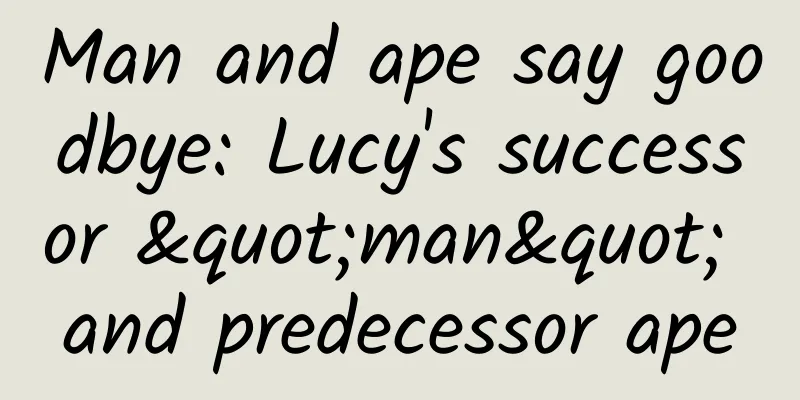Man and ape say goodbye: Lucy's successor "man" and predecessor ape

|
In 1924, the 13th year of the Republic of China, China was in a turbulent period - the vigorous National Revolution and the Northern Expedition were in full swing. Thousands of miles away in the Western Hemisphere, young scholar Raymond Dart had just finished his studies in the UK. Dart, who had completed his studies, did not return to his hometown of Australia, but came to South Africa to become a professor of anatomy. He had an extraordinary interest in fossils and often encouraged students to go out to look for fossils in their spare time. In that year, a student sent him a baboon skull fossil, which came from a nearby quarry. Raymond Dart | Smithsonian Institution Archives Dart, who was obsessed with bones, found the quarry owner and bought two boxes of fossils. The following year, he published his blockbuster research: a skull that looked both ape-like and human-like was found among the fossils, and its morphology showed that the owner of the skull could balance his head above the spine without tilting forward - a reflection of an upright posture. Because the fossil was found in the southernmost part of Africa, Dart named it "Australopithecus". The origin of the super family However, after the study was published, Dart was ridiculed. Many authoritative scholars in the fields of anatomy and anthropology ridiculed the specimen as "more like a mutilated chimpanzee than a human." The skull discovered by Dart in 1925 | James St. John / Wikimedia Commons However, opposition and ridicule were only secondary. Dart's research was simply ignored for more than ten years. In 1927, the Zhoukoudian site in Beijing was excavated, and the attention of anthropologists around the world was attracted by the newly discovered "Peking Man". The Australopithecus, which was overshadowed, fell into obscurity. In 1936 and 1938, two more Australopithecus fossils were unearthed in South Africa, but they were still not taken seriously by the academic community because they were not recognized at all. The Australopithecus fossils discovered in 1936 and 1938 were very different from Dart's specimen. Scholars at the time named them two new groups, "Parahuman" (meaning close to humans) and "Paranthropus" (meaning a side branch of human evolution), but they did not realize that these fossils were actually Australopithecus. Paranthropus skull discovered in 1938 | José Braga; Didier Descouens / Wikimedia Commons In the following decades, more than 70 ape fossils were found in five locations in South Africa, with hundreds of specimen numbers. The discoverers gave them four genus names and six species names. Many scholars argued about it and finally began to feel that something was wrong - these fossils were of similar ages and locations. Could it be that so many different species of ancient humans had no competition and could live in harmony? Fortunately, with more fossils, a research system was established. By eliminating age, gender, and individual differences, all these fossils found in South Africa were classified into one genus (Australopithecus) and two species (slender species and robust species). However, this was just the beginning of the establishment of the Australopithecus family: In 1959, people discovered "Bois's East African Man" (later reclassified as Australopithecus Bois) in Tanzania; In 1974, the famous "Lucy" was discovered in the Afar region of Ethiopia (at that time it was classified as Australopithecus gracilis, but later it was found to be a new species named "Afar"); Australopithecus afar (Lucy) | Shanghai Natural History Museum In 1994, a large number of fossils dating back 4.4 million years ago were unearthed in the Afar region and were named Australopithecus afarensis, the oldest direct ancestor of humans discovered so far; In 1995, researchers isolated the "lake species" from the fossils of the ancient Australopithecus in Kenya. In 2015, still in Afar, people discovered another "relative" of Australopithecus. Man and ape say goodbye: Lucy's successor "man" and predecessor ape What is the relationship between these many species of Australopithecus? Research has shown that the Australopithecus species is worthy of its name and is the ancestor of all other Australopithecus species. Later, they were simply separated and classified into a new genus of Ardipithecus, renamed "Australopithecus ancestor". The lake species followed the original ancestor and lived between 4.2 and 3.8 million years ago. The Afar species, to which Lucy belongs, lived between 3.9 and 2.9 million years ago. The most recently discovered relative lived between 3.5 and 3.3 million years ago. The skull of Australopithecus anamensis (left) and reconstruction of the fossil face | Fred Spoor In the past, researchers believed that the Afar species was a descendant of the anamensis species, but later it was discovered that the two species had overlapping distribution times and may have been siblings. This also led to controversy about Lucy's ancestry: Did the Afar species evolve directly from the ancestral ape, or was it a differentiation of the early anamensis species? Skull of Ardipithecus | Rama / Wikimedia Commons Compared to the lakeside species and Ardipithecus spp., which still look like monkeys, the characteristics of the Afar species are between humans and apes, and its ape-like characteristics are clearly changing towards humans. Therefore, the Afar species is considered to be the ancestor of both the slender species and the "Homo habilis" - the former evolved into the robust species and the bonito species, and the latter evolved into modern humans, and this is where humans and apes separate. However, the discovery of the closely related species (basically the same period as the Afar species) in 2015 has raised another question - are we descendants of the closely related species, or of the Afar species to which Lucy belongs? Among the Apes: Lucy's Life However, even if Lucy is not our direct ancestor, she is at least our great-great-aunt. What did Lucy, the so-called "between man and ape", look like and what kind of life did she lead? The height of Australopithecus is about 1.2 meters to 1.4 meters. If you only look at the upper body, it is almost completely an ape. However, their structure below the waist is very similar to that of modern humans - that is, they do not have "four hands" like chimpanzees, but have distinct hands and feet like us, and usually walk upright. But their upper arms are still very similar to chimpanzees, indicating that Australopithecus often climbs trees. Lucy's arm has a fracture caused by falling from a height. She may have died from falling from a tree - this reflects that Australopithecus can climb trees, but perhaps not as skilled as their ancestors who originally lived in trees. Model of a male Australopithecus, on display at the Natural History Museum in Vienna, Austria | Wolfgang Sauber / Wikimedia Commons The skull of Australopithecus afarensis is short and low compared to modern humans, but longer and taller than that of chimpanzees. Its brain capacity is also small, only about 380-430 cubic centimeters, about the same size as chimpanzees, but its structure is very similar to that of modern humans. In terms of skull proportions, the face of Australopithecus is extremely large, and the chin protrudes forward - the large face and long chin may be for chewing leaves, fruits, wood and bark, which are extremely tooth-consuming and constitute the staple food of Australopithecus, so strong chewing muscles are needed. However, Lucy and her tribe are not pure vegetarians. If they come across protein-rich foods such as insects and bird eggs, they will not let them go. A skull of an Australopithecus afarensis on the left and a chimpanzee skull on the right | Rama (left), Luis Fernández García (right) / Wikimedia Commons As for hunting, forget it. A group of Australopithecus, whose height and physique are like those of elementary school students and whose IQ may not even be as good as that of kindergarten children, really cannot hunt wild animals on the grasslands. Moreover, Australopithecus cannot use fire and probably cannot make stone tools. (It is generally believed that the invention of stone tools was made by Homo habilis, the descendant of Australopithecus. This is also the reason why Homo habilis got the name - he can make stone tools, so he is a capable person.) Finally, the Afar species to which Lucy belonged is sometimes translated as "Afar species", but don't remember it incorrectly as the Greek letter "Alpha" - however, if you make a mistake, it's not a big deal. Many museum signs in China mistakenly write "Alpha". This article comes from the Species Calendar, welcome to forward If you need to reprint, please contact [email protected] |
>>: Will scratching the inner pot of a rice cooker be harmful to human health?
Recommend
Breaking down age stereotypes: Five common myths about older people
Source: Science Refutes Rumors...
The market will be bigger. Mark Zuckerberg called at the United Nations to allow more people around the world to access the Internet.
[[150638]] Facebook CEO Mark Zuckerberg called fo...
Operational Strategies for Internet Finance Users (I)
There are three articles in the series "Touc...
100 days, 1000 meters, a new starting point
Today marks the 13th month that Tianwen-1 has bee...
Is soup more nutritious than meat? Soup contains more fat! These three types of people should be careful when drinking soup
Is soup more nutritious than meat? Soup contains ...
The sample adulteration rate is as high as 83%. Is your silk quilt "authentic"?
A new year, a new beginning, and a new big speech...
Do you have a special liking for poultry? Be careful of "parrot fever" knocking on your door! Here are some tips on how to prevent it~
Experts from Yiyang Central Hospital remind peopl...
Wuhan University: The dormitory with cholera cases is no longer sealed! Virulence gene is negative, so why does it still cause disease?
According to the official Weibo of Wuhan Universi...
“Riding on the popularity” doesn’t work anymore? No, it was ruined!
At the beginning of the article, we are going to ...
Dancers in the fields? A poetic revolution in mechanized sowing!
The miracle of mechanized seeding Under the golde...
Here are the 4 essential skills for new media writing!
The popularity of WeChat has also brought about a...
Guide to editing information flow ads!
This article will share some key points and techn...
[Smart Farmers] Eating and appreciating dates: the date culture unique to the Chinese
Chinese people have an indissoluble bond with juj...
Xiaomi Notebook Air: The hard part is not just the ridiculous PPT
On July 27, Xiaomi, a well-known domestic mobile ...









